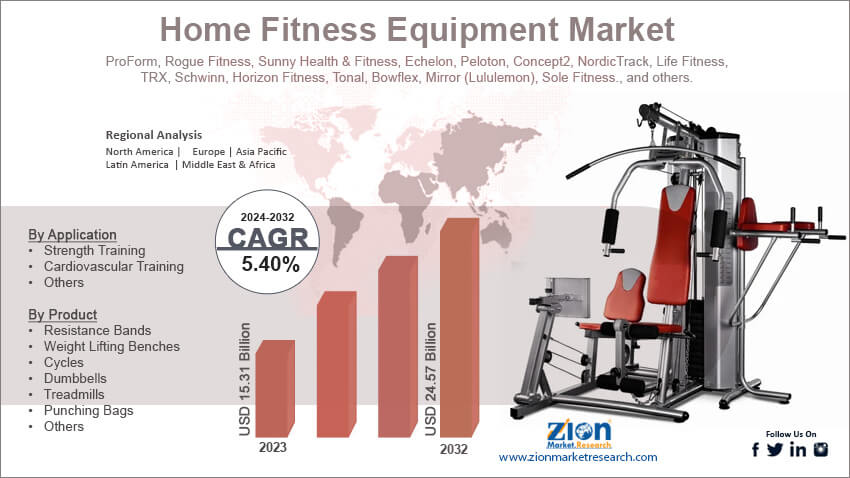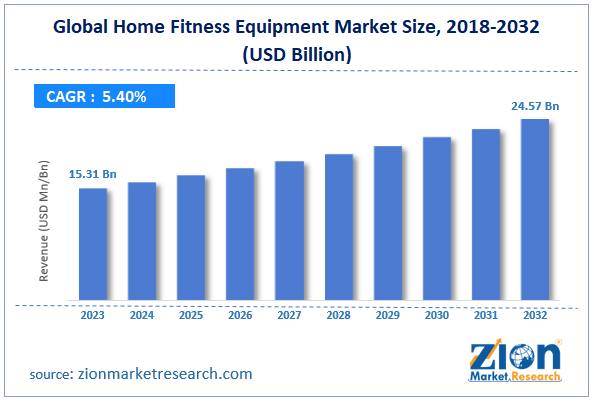Home Fitness Equipment Market Size, Share, Analysis, Trends, Growth Report, 2032

Home Fitness Equipment Market By Application (Strength Training, Cardiovascular Training, and Others), By Product (Resistance Bands, Weight Lifting Benches, Cycles, Dumbbells, Treadmills, Punching Bags, and Others), By Sales Channel (Offline and Online), and By Region - Global and Regional Industry Overview, Market Intelligence, Comprehensive Analysis, Historical Data, and Forecasts 2024 - 2032-
| Market Size in 2023 | Market Forecast in 2032 | CAGR (in %) | Base Year |
|---|---|---|---|
| USD 15.31 Billion | USD 24.57 Billion | 5.40% | 2023 |
Home Fitness Equipment Industry Prospective:
The global home fitness equipment market size was worth around USD 15.31 billion in 2023 and is predicted to grow to around USD 24.57 billion by 2032 with a compound annual growth rate (CAGR) of roughly 5.40% between 2024 and 2032.
Home Fitness Equipment Market: Overview
The home fitness equipment industry deals with the production and distribution of exercise equipment designed ideal for homes and residential units. Unlike fitness equipment found in gymnasiums and other exercise facilitation centers, home equipment allows consumers to exercise in the comfort of their homes. Generally, home fitness machines occupy less space and offer portability as opposed to commercial equipment. However, depending on the consumer's budget and space availability, it is possible to invest in commercial fitness equipment for home environments.
In addition to this, equipment used for exercise at home is less expensive than its commercial counterparts. The online market space is filled with several innovative equipment designed for home workouts leading to higher market revenue. During the projection period, the demand for home fitness equipment is expected to be influenced by greater product innovation and rising health awareness. However, the high cost of superior-grade fitness equipment and space constraints may limit the home fitness equipment industry’s expansion rate.
Key Insights:
- As per the analysis shared by our research analyst, the global home fitness equipment market is estimated to grow annually at a CAGR of around 5.40% over the forecast period (2024-2032)
- In terms of revenue, the global home fitness equipment market size was valued at around USD 15.31 billion in 2023 and is projected to reach USD 24.57 billion by 2032.
- The home fitness equipment market is projected to grow at a significant rate due to the growing health consciousness among the general population
- Based on the application, the cardiovascular training segment is growing at a high rate and will continue to dominate the global market as per industry projection
- Based on the sales channel, the online segment is anticipated to command the largest market share
- Based on region, North America is projected to dominate the global market during the forecast period
 Request Free Sample
Request Free Sample
Home Fitness Equipment Market: Growth Drivers
Growing health consciousness among the general population will drive market demand rate
The global home fitness equipment market is expected to be driven by the rising health consciousness among the general population. COVID-19 acted as an excellent promoter of home workouts since most commercial exercise-based establishments were non-functional during lockdown impositions. In addition to this, desk jobs have resulted in a growing number of people living a sedentary lifestyle, which is often associated with several medical conditions.
For instance, an inactive lifestyle is a leading cause of obesity in the younger generation. It is also linked to more serious health issues such as cardiovascular diseases, musculoskeletal disorders, and metabolic syndrome. The lack of exercise in the everyday lives of many people is influenced by several factors, such as long working hours, limited accessibility to commercial gymnasiums, and a generally busy lifestyle. In such cases, home fitness equipment allows users to exercise as per their schedule and during free time. The equipment limits dependency on commercial gyms and fitness centers for exercising throughout the day.
Surging introduction of home workout applications will promote market revenue during the projection period
The demand for home equipment is expected to benefit from the introduction of digital applications and systems facilitating home workouts. These applications offer exercise plans depending on the fitness needs of the users. Most applications offer additional features such as tracking sleep, the number of steps a day, and other health parameters, including heart rate and blood pressure. Some applications are available at zero cost, while others run on a subscription-based model. For instance, in February 2024, Zumba, a leading player in the global dance fitness industry, announced the launch of a new application called the Zumba® App. It offers features such as in-person classes, easy accessibility, and options to schedule workouts, thus promoting demand in the global health fitness equipment market.
Home Fitness Equipment Market: Restraints
High cost of certain equipment and space constraints will limit the industry’s growth rate
The global industry for home fitness equipment is expected to be restricted due to the high cost of specific equipment. Good quality machines required for exercising at home are expensive. For instance, budget treadmills can cost between USD 500 and USD 1,000. The price increases further with the addition of smarter features. Additionally, home workout equipment has space-related demands. Compact houses with limited space may not be appropriate for storing or using home fitness equipment, limiting product adoption rate.
Home Fitness Equipment Market: Opportunities
Rising investments in product innovation may prompt further expansion opportunities in the future
The global home fitness equipment market is expected to generate more growth opportunities in the coming years due to investments in product innovation. Home fitness equipment developers are focusing on improving product performance while experimenting with other aspects, such as machine portability and extended functionality. In September 2022, Flexnest, an Indian direct-to-consumer (D2C) fitness brand, announced the launch of Flexpad. It is the country’s first Smart Connected walking pad offering over 500 trainer-guided workouts and more than 50 virtual walks. In October 2023, the world’s most popular sports apparel company, Nike, launched Nike Strength, thus officially making its entry into the weight equipment market. The subsidiary develops and delivers home gym equipment. Expansion into new markets and product categories could further benefit market players in the long run.
Home Fitness Equipment Market: Challenges
Competition from commercial fitness centers is a challenge for the companies operating in the industry
The global home fitness equipment market is expected to be challenged by the rising competition the industry faces from commercial fitness centers. Since the COVID-19 lockdown impositions have lifted, there has been a sharp rise in the number of fitness and wellness centers globally. These facilities are equipped with state-of-the-art fitness equipment and experienced trainers who assist in achieving health goals under supervision. Additionally, market studies suggest that home workouts may not be as effective as commercial establishments in achieving fitness aims.
Home Fitness Equipment Market: Segmentation
The global home fitness equipment market is segmented based on application, product, sales channel, and region.
Based on the application, the global market segments are strength training, cardiovascular training, and others. In 2023, the highest demand was observed in cardiovascular training. These exercises can be performed with minimal equipment, such as light-weight dumbbells or body weight. For instance, skipping is considered an effective exercise for getting the heart rate up. Strength training generally requires extensive investments in larger equipment that are expensive. According to official reports, more than 59% of the American population owns a personal treadmill.
Based on product, the global home fitness equipment industry is divided into resistance, bands, weight lifting benches, cycles, dumbbells, treadmills, punching bags, and others.
Based on the sales channel, the global market divisions are offline and online. In 2023, the highest demand was observed in the online segment. The segmental demand is affected by the higher availability of options on online sales platforms. In addition, the ease of shopping and access to several incentives promote the use of e-commerce channels for the sale of basic home fitness equipment. Around 40% of global consumers prefer to shop for sports equipment through online channels.
Home Fitness Equipment Market: Report Scope
| Report Attributes | Report Details |
|---|---|
| Report Name | Home Fitness Equipment Market |
| Market Size in 2023 | USD 15.31 Billion |
| Market Forecast in 2032 | USD 24.57 Billion |
| Growth Rate | CAGR of 5.40% |
| Number of Pages | 228 |
| Key Companies Covered | ProForm, Rogue Fitness, Sunny Health & Fitness, Echelon, Peloton, Concept2, NordicTrack, Life Fitness, TRX, Schwinn, Horizon Fitness, Tonal, Bowflex, Mirror (Lululemon), Sole Fitness., and others. |
| Segments Covered | By Application, By product, By Sales Channel, and By Region |
| Regions Covered | North America, Europe, Asia Pacific (APAC), Latin America, Middle East, and Africa (MEA) |
| Base Year | 2023 |
| Historical Year | 2018 to 2022 |
| Forecast Year | 2024 - 2032 |
| Customization Scope | Avail customized purchase options to meet your exact research needs. Request For Customization |
Home Fitness Equipment Market: Regional Analysis
North America to lead the market growth rate during the projection period
The global home fitness equipment market is expected to be led by North America during the projection period. The demand for home workout machines and tools is higher in regions such as the US and Canada. The rising health consciousness among North American citizens is driven by a surge in the number of patients with obesity and cardiovascular diseases. Memberships at commercial fitness centers can be expensive in North America encouraging more people to opt for other forms of workouts, such as running or using wellness equipment at home.
According to a survey by Tribe Fitness, around 57% of the respondents work at home. In August 2024, US-based BASI Systems, a leading developer of Pilates equipment, announced the launch of BASI Systems Compact Reformer. It offers space-saving design and exceptional versatility. Europe is expected to emerge as one of the most influential regions over the forecast period. Product innovation will drive regional demand as per market research. In June 2024, Paris-based luxury fashion house Celine launched a new collection of luxurious Reformer Pilates machines. Higher health awareness among European citizens and demand for customized fitness equipment will fuel the market expansion rate. According to Yogkulam, around 39% of European citizens participate in yoga-based exercises frequently.
Home Fitness Equipment Market: Competitive Analysis
The global home fitness equipment market is led by players like:
- ProForm
- Rogue Fitness
- Sunny Health & Fitness
- Echelon
- Peloton
- Concept2
- NordicTrack
- Life Fitness
- TRX
- Schwinn
- Horizon Fitness
- Tonal
- Bowflex
- Mirror (Lululemon)
- Sole Fitness.
The global home fitness equipment market is segmented as follows:
By Application
- Strength Training
- Cardiovascular Training
- Others
By Product
- Resistance Bands
- Weight Lifting Benches
- Cycles
- Dumbbells
- Treadmills
- Punching Bags
- Others
By Sales Channel
- Offline
- Online
By Region
- North America
- The U.S.
- Canada
- Europe
- France
- The UK
- Spain
- Germany
- Italy
- Rest of Europe
- Asia Pacific
- China
- Japan
- India
- South Korea
- Southeast Asia
- Rest of Asia Pacific
- Latin America
- Brazil
- Mexico
- Rest of Latin America
- Middle East & Africa
- GCC
- South Africa
- Rest of Middle East & Africa
Table Of Content
Methodology
FrequentlyAsked Questions
The home fitness equipment industry deals with the production and distribution of exercise equipment designed ideal for homes and residential units.
The global home fitness equipment market is expected to be driven by the rising health consciousness among the general population.
According to study, the global home fitness equipment market size was worth around USD 15.31 billion in 2023 and is predicted to grow to around USD 24.57 billion by 2032.
The CAGR value of the home fitness equipment market is expected to be around 5.40% during 2024-2032.
The global home fitness equipment market is expected to be led by North America during the projection period.
The global home fitness equipment market is led by players like ProForm, Rogue Fitness, Sunny Health & Fitness, Echelon, Peloton, Concept2, NordicTrack, Life Fitness, TRX, Schwinn, Horizon Fitness, Tonal, Bowflex, Mirror (Lululemon) and Sole Fitness.
The report explores crucial aspects of the home fitness equipment market including a detailed discussion of existing growth factors and restraints while also browsing future growth opportunities and challenges that impact the market.
HappyClients
Zion Market Research
Tel: +1 (302) 444-0166
USA/Canada Toll Free No.+1 (855) 465-4651
3rd Floor,
Mrunal Paradise, Opp Maharaja Hotel,
Pimple Gurav, Pune 411061,
Maharashtra, India
Phone No +91 7768 006 007, +91 7768 006 008
US OFFICE NO +1 (302) 444-0166
US/CAN TOLL FREE +1 (855) 465-4651
Email: sales@zionmarketresearch.com
We have secured system to process your transaction.
Our support available to help you 24 hours a day, five days a week.
Monday - Friday: 9AM - 6PM
Saturday - Sunday: Closed






